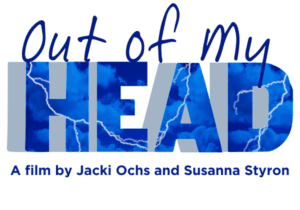 In February 2018 Out of My Head, premiered for a weeklong run at the Museum of Modern Art in New York City. This was the beginning of an ongoing journey to utilize this film to inform and educate the worldwide public about a deeply misunderstood and stigmatizing neurological disease which is commonly characterized by excruciating head pain but is actually a multitude of complex and often bizarre symptoms.
In February 2018 Out of My Head, premiered for a weeklong run at the Museum of Modern Art in New York City. This was the beginning of an ongoing journey to utilize this film to inform and educate the worldwide public about a deeply misunderstood and stigmatizing neurological disease which is commonly characterized by excruciating head pain but is actually a multitude of complex and often bizarre symptoms.
The backbone of our film is the journey taken by director Susanna Styron and her daughter, Emma, who, as a teenager, becomes afflicted with migraine. As we accompany them on their quest for understanding and ever-elusive treatment, we hear from doctors, neuroscientists, and others who suffer with migraine. This mother/daughter journey takes us on a wild ride through migraine’s fascinating history, amid subjects ranging from chronic pain to the gut/brain connection to art and spirituality.
Early in the process of constructing the film, we recognized the challenge of visualizing and defining the nature of pain. Migraine, like most forms of pain, rarely manifests visually. As Siri Hustvedt’s husband Paul Auster says in our film,
“What I see is often the circles under her eyes. That’s when I know she’s under it. But I don’t see any particular extra tension in her face. She doesn’t grimace. So, no, it’s invisible. It’s absolutely invisible. “
The primary vehicle we chose for visualizing migraine was an extraordinary collection of artworks created by people who suffer from the disease. The visions expressed by these patients — from Rube Goldberg-like machines of torture to exploding kaleidoscopic television sets — dynamically portray the pain and suffering they cannot verbalize.
For defining pain we turned to the experts. How do medical practitioners diagnose and evaluate their patients’ experiences? We are told that pain is subjective; there is no objective way to measure it. Complicating matters is the fear of pain. As Dr. David Borsook explains:
“The emotional component of pain cannot really be separated from pain intensity because it’s all part of how our brain circuit puts things together.”
For narratives of the experience of pain, we naturally turned to people with migraine. Among the voices are those of an Iraq war veteran whose migraine attacks stem from combat-related traumatic brain injury; a college professor deciding whether she dare go off her migraine medication to have a second child; a husband who becomes a migraine activist on his wife’s behalf; and Joan Didion, reading from her legendary essay “In Bed.”
Their stories present anecdotal evidence that, for many, grappling with the fear of oncoming pain and trying to ‘accept’ rather than resist what is happening can reduce perception of pain intensity. We further learn that with the chronic pain of migraine, there is often a limit to what traditional medicine can provide; and that a holistic approach to monitoring one’s lifestyle and habits with attention to stress reduction and physical health are potentially quite beneficial.
Migraine remains a mystery to medical science. Out of My Head makes clear that only with additional research can the mechanism of the disease be fully understood, thereby increasing the potential for finding a cure. What we do recognize now is the far-reaching impact of migraine. In addition to telling a fascinating story, our film illuminates a terribly misunderstood illness, building much-needed empathy for those who live with this crippling disease which afflicts over a billion people worldwide.
Jacki Ochs, Producer
Susanna Styron, Writer/Director
For more information, visit https://www.outofmyheadfilm.com/ and The Migraine Research Foundation, https://migraineresearchfoundation.org
